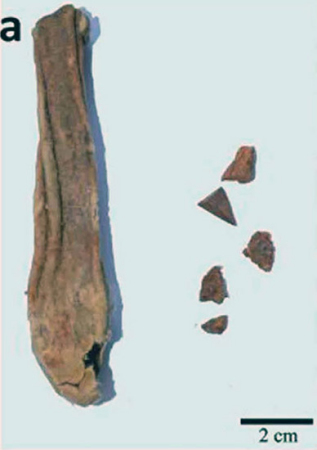
A leather bag and cosmetic sticks have been excavated from Xiaohe Cemetery. (Photo/China Daily)
Thousands of years before the glitz and glamour of modern fashion, ancient residents in today's Xinjiang were already taking cosmetics to heart.
Chinese scientists have discovered two "cosmetic sticks" unearthed from Xiaohe Cemetery in northwest China's Xinjiang Uygur Autonomous Region that were made from the hearts of cattle, the first time such organs have been found to serve as cosmetic tools.
Dating back about 3,600 years ago, the irregularly-shaped red "sticks" were found in leather bags laid beside female mummies. The bodies were placed in boat-shaped wooden coffins and buried with objects such as wooden combs and wooden phallus, believed to be symbols of fertility worship, according to an article published in the journal Scientific Reports.
A team led by Yang Yimin with the University of Chinese Academy of Sciences employed proteomics analysis and found the objects' proteins were derived from bovine hearts. Using SR micro CT and Raman spectrum, they found a layer of hematite powders, which served as red pigment, on the dehydrated hearts.
"The red paint found on faces of the female mummies leads us to presume the tools were, first of all, used in make-up," Yang told Xinhua on Thursday, while not ruling out the possibility of the hearts being used to paint other objects.
Heart muscles contain fat and collagen, which can serve as a natural adhesives to attach the pigments to paint. Yang also believed the use of cattle heart might carry religious connotations.
Red paints were commonly found inside Xiaohe tombs, from red lines on the mummies' foreheads to painting on the huge pillars worshipping fertility in front of each coffin. That the sticks were mostly buried beside female mummies implied that women played a special role in the religious ritual of painting in red, researchers said.
The study has provided clues to understanding the role of cattle in the Xiaohe Culture, which existed about 4,000 years ago, and the history of early cosmetics, according to Yang.
The Xiaohe Cemetery, located in the Taklamakan Desert, is best known for its many mummies in ship-shaped coffins. Archaeologists say the dry and hot environment helped preserve a large number of organic relics.
The site has seen a number of amazing discoveries, including a skull with a hole indicating brain surgery and China's oldest adhesive made from cattle gelatine, found on a ritual staff and also identified by Yang's team.


















































